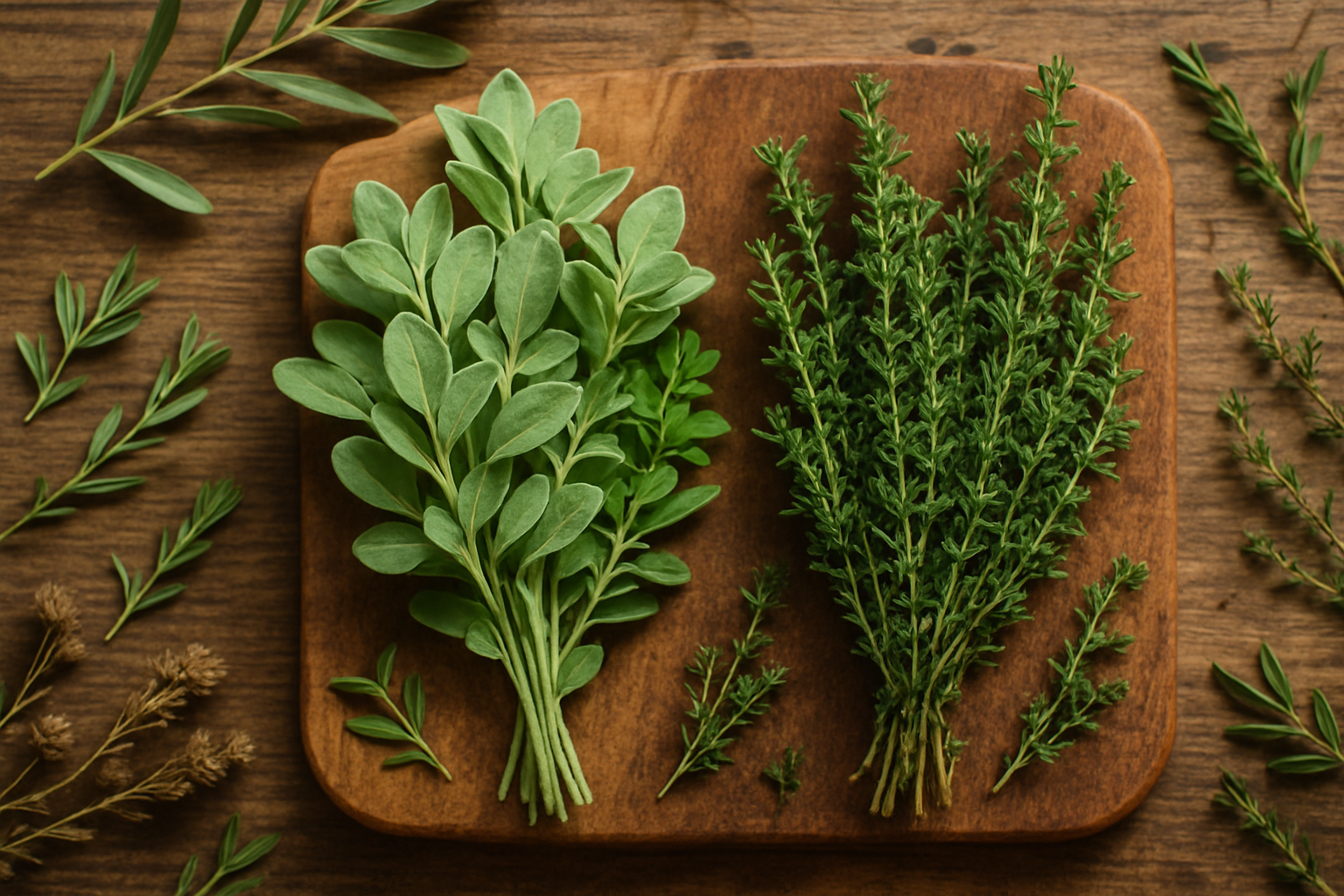What Are Marjoram and Thyme?

When it comes to elevating your culinary creations and garden, understanding the differences between marjoram vs thyme can open up a new world of flavors and greenery. Both marjoram (Origanum majorana) and thyme (Thymus vulgaris) hail from the Mediterranean region and were historically valued by Greek and Roman civilizations for their aromatic leaves and medicinal uses.
Marjoram typically boasts soft, oval-shaped, pale green leaves and a subtle, sweet fragrance, while thyme is a hardy, woody-stemmed herb with tiny, deep green leaves and a bolder, more earthy scent.
Flavor Differences
Flavor-wise, the distinction is striking. Marjoram offers delicate notes of citrus and pine with a gentle sweetness, making it a go-to herb in French and Middle Eastern dishes like herbes de Provence blends or za’atar seasoning. Thyme, on the other hand, packs a punch with its warm, peppery, and slightly minty taste, holding its own in hearty Mediterranean stews, roasted meats, and classic Italian sauces.
Whether you’re snipping fresh herbs from the garden or reaching into your spice cabinet, knowing how marjoram vs thyme differ in both flavor and aroma lets you choose the right touch for your next kitchen adventure.
Distinctive Tastes and Culinary Uses
Marjoram and thyme both add depth to dishes, but their flavors set them apart in the kitchen. Marjoram is known for its sweet, floral, and slightly citrusy notes, offering a gentle, almost delicate undertone that brightens vegetables, tomato sauces, or light proteins like chicken and fish. In contrast, thyme delivers a more robust, earthy, and slightly pungent flavor with subtle minty hints, making it a staple in heartier dishes.
Mediterranean cuisine often uses marjoram to highlight subtle flavors without overpowering them—think of it sprinkled over roasted zucchini, added to Greek salads, or stirred into French vinaigrettes. Thyme, meanwhile, stands up well to slow-cooked meats, rich stews, and soups; it’s especially good with beef, lamb, or root vegetables in classic dishes like coq au vin or beef stew.
Marjoram pairs beautifully with eggs, poultry, and delicate fish, while thyme is fantastic with potatoes, mushrooms, and pulses like lentils. For cooks looking to experiment, try marjoram with lemon or fresh cheeses, and rely on thyme when cooking with wine, garlic, or tomatoes—each herb’s unique character will shine in the appropriate setting.
Marjoram vs Thyme: Nutrition and Health Benefits
Marjoram and thyme are both nutrient-rich herbs, each offering unique benefits to your plate. Marjoram is packed with vitamins A and C, as well as iron and calcium, making it great for immune support and bone health. Thyme, on the other hand, shines with a high vitamin K content, which supports proper blood clotting and strong bones, along with notable amounts of manganese and fiber.
Both herbs are low in calories—typically under 5 calories per tablespoon—so you can use them liberally without worry. While thyme’s slightly higher fiber content aids digestion, marjoram’s antioxidants may help reduce inflammation.
Try sprinkling marjoram on roasted veggies or thyme in homemade soups for both extra flavor and an easy nutrient boost.
Using Fresh vs Dried Marjoram and Thyme

Fresh marjoram and thyme offer brighter, more delicate flavors compared to their dried counterparts, which develop earthier and more concentrated tastes during drying. If a recipe calls for fresh herbs but you only have dried, use about one-third the amount—so, 1 teaspoon dried for every 1 tablespoon fresh. Conversely, if you’re substituting fresh for dried, triple the amount.
Add dried herbs earlier in the cooking process to allow their flavors to infuse, while fresh herbs are best tossed in at the end for maximum aroma and taste.
For storage, fresh marjoram and thyme can last up to a week in the fridge when wrapped in damp paper towels and placed in a plastic bag. Dried versions, stored in airtight containers in a cool, dark spot, can keep for up to a year.
Best Substitutes for Marjoram and Thyme
When you’re out of marjoram, oregano makes the best substitute thanks to its similar herbal notes, though it’s stronger—use about two-thirds the amount to avoid overpowering your dish. For thyme, fresh or dried savory can stand in well, but it’s slightly pepperier, so start with half the amount and add more to taste.
Italian seasoning blends can replace both herbs in a pinch, but they’ll bring extra flavors like basil or rosemary, so adjust your recipe accordingly.
Keep in mind these swaps work best in savory dishes like soups, stews, or roasted vegetables. For delicate recipes like herbal teas or lightly flavored sauces, substitutions might throw off the balance—when in doubt, it’s better to wait until you have the real thing.
Tips for Cooking with Marjoram and Thyme
When cooking with marjoram and thyme, timing is key to unlocking their best flavors. Marjoram’s delicate, sweet notes shine when added near the end of cooking, making it perfect for sprinkling over roasted vegetables or stirring into tomato-based sauces just before serving.
Thyme, on the other hand, holds up well to longer cooking times, making it ideal for slow-simmered stews, soups, and braised meats—just remember to remove the woody stems before serving.
Both herbs pair beautifully with chicken, potatoes, or Mediterranean dishes like ratatouille.
For first-time home cooks, start with small amounts—about half a teaspoon per dish—to avoid overpowering your food. Taste as you go, and don’t be afraid to experiment; fresh or dried forms both work well, just use about three times less if you’re substituting dried for fresh.
FAQs: All About Marjoram and Thyme
Marjoram and oregano are often confused, but marjoram has a milder, sweeter taste, while oregano is more robust and spicy—perfect for Mediterranean dishes.
If you’re out of marjoram, thyme can often stand in, especially in soups or stews, though the flavor will be slightly earthier.
Oregano isn’t always a great substitute for marjoram since it can overpower delicate recipes. However, in hearty dishes, you can swap them in a pinch. For the best results, use slightly less oregano than the recipe calls for marjoram, and add a pinch of sweetness to mimic marjoram’s gentle profile.
